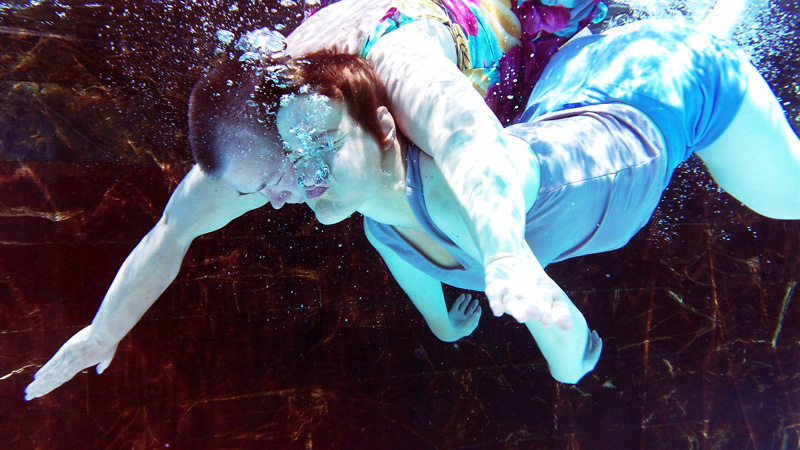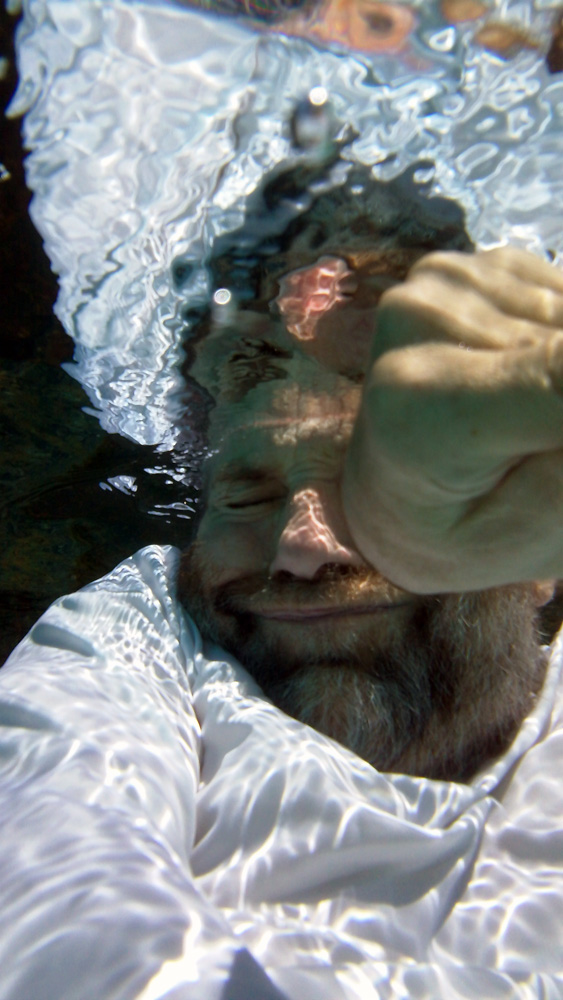Sunny Taylor and Petra Kuppers
Salamander
Project Description
Salamander is a community performance project. We use underwater photography, dry performance workshops, creative writing, clay work and video to go under, to find our disabled beauty emerging from the deep, the wild aesthetic of water, deforming ourselves through sleek unhinged control.
Since May 2013, disabled people and their allies from around the world have climbed into pools and oceans with us, and we float together, enjoying complicated freedom, companionship and adventure. And we give ourselves to the pressures the waters exert on us.
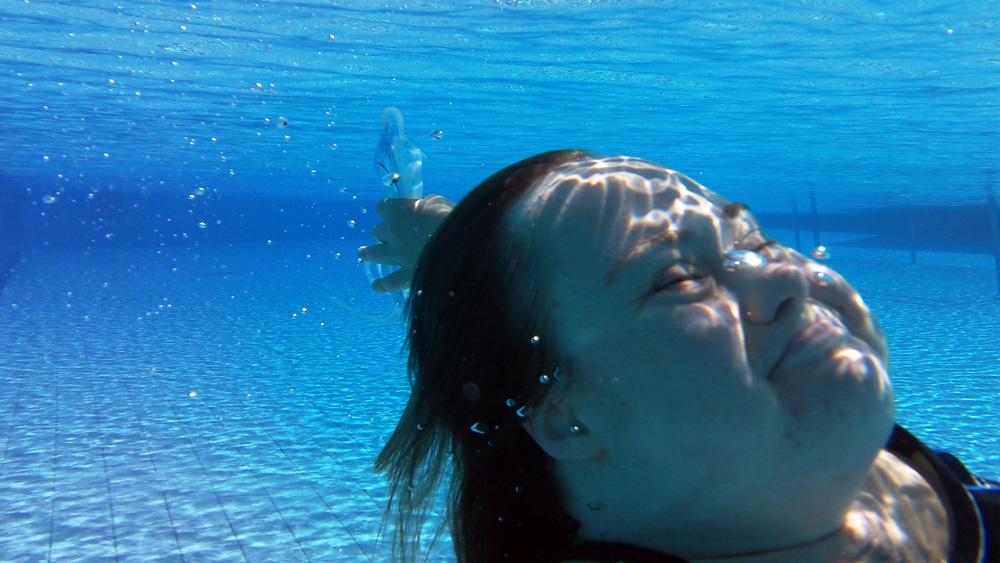
Josie Noble
There is little instruction in Salamander swims: the water is the director, the choreographer, as we twist freely in gravity, trusting each other, exploring the integrity of our bodies. We also chat while we are in the water, and explore the easy flow of communication in the fluid medium of supportive water. The emphasis is on play and process.
In a poem on the Salamander list-serv that accompanies our art/life project, Neil Marcus, a spastic performance artist, writes about the importance of touch, and about touch through water. With Salamander, we are translating the touch erotics used in many Olimpias workshops into a different realm of calming pressure.
Salamander art practices have included writing, movement, photographs, videos and clay work. We gift underwater photos to our participants, through the shared social world pool of facebook: witnesses to allow us to see ourselves, deformed and transformed in ways that humans hardly ever see each other. There is beauty in the loss of control, in the letting go, in giving ourselves to new pressures. The images stand as witnesses to the power of transformation, to the way we are in performance process, how we can open ourselves to being touched by the world.
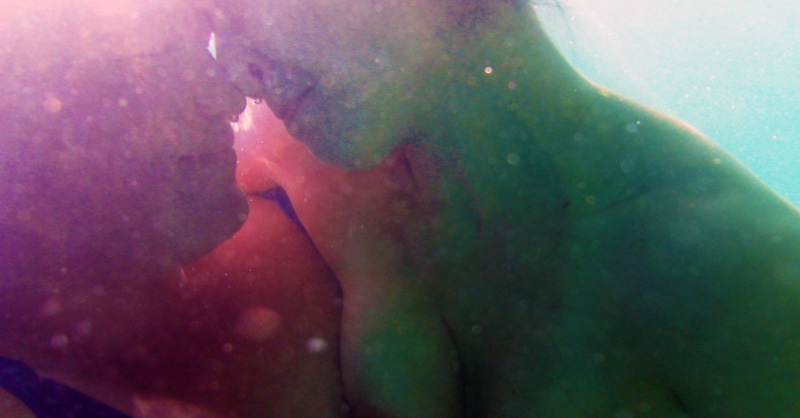
Rita Joplin and Petra Kuppers, Mediterranean Sea by Nova Icaria, Spain
Workshop Instructions
For a wet workshop, we meet at a swimming pool, in your bathing clothes if you are going into the water, with something to write if you are not – there will be engagement options for swimmers and for non-swimmers. Duration: about one hour. Ideally, we’ll all go and have something to eat and drink together afterward: breaking bread and building community is very much part of the project.
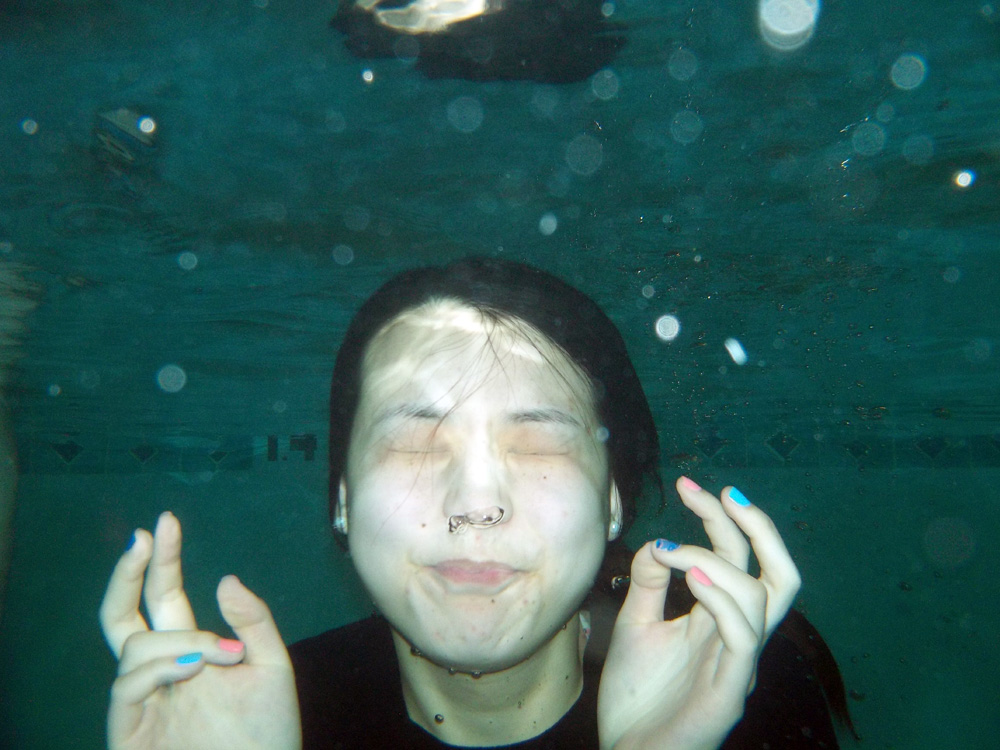
Sandy Chung
Salamander free write instruction (feel free to take up these invitations):
As part of our project, we engage in free writes. There are a number of instructions we use (and then we spin off from them):
- use one of the existing Salamander photos as your cue. Look closely, and begin writing from there.
- use a particular cue, like ‘wildness,’ or just use the connotations that come up when you think of salamanders: what do they signify for you? Are they familiar or strange? Do you think of actually existing creatures, or of the mythical salamander of alchemy, one of the four magic beasts, the creature that stands between fire and water? Do you have an alchemical or magical creature?
- Think about how disability signifies in public, and notions of beauty, rareness, transformation. Write from there.
People can choose to make their freewrites public, and we have three two different venues for this – a listserv, just with people who have been in salamander sessions and chose to join the list-serv; facebook, our wider public pool; and the Olimpias website.
There is also a clay work component to Salamander: making and gifting salamander eggs, by creating small palm-sized pinch pots, lined with our lines, the marks of our fingers and our life lines.
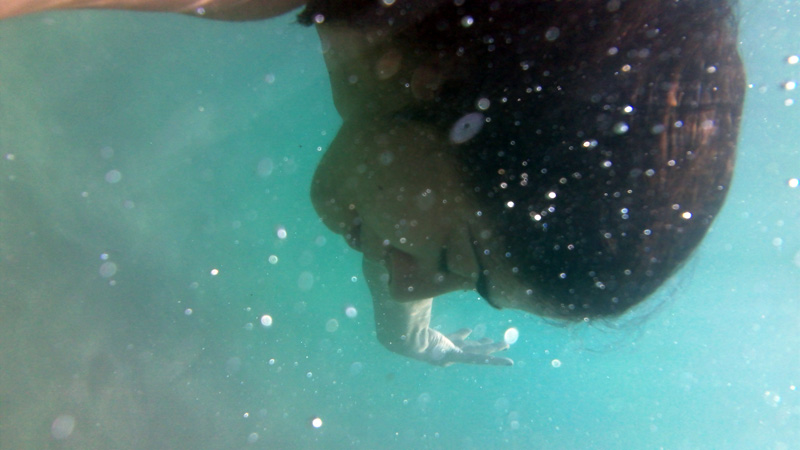
Rita Joplin
Call History
Dear everybody, Olimpias collaborators and Bay area friends,
We would like to invite you to the 2013 Olimpias Disability Culture summer performance actions, Salamander, a project to find our disabled beauty emerging from the deep, the wild aesthetic of water, deforming ourselves through sleek unhinged control. Here be dragons.
We would like to invite you to small-scale swim dates in various pools around the Bay, at various times, about once a week. If you are interested in participating in our actions, and would like to be on the invite list, or like to suggest accessible pools, rivers, lakes and such, just email petra@umich.edu. The sessions are designed to be intimate, up to five people at a time. Together, we'll work out what it will all be, how it can be accessible for different bodyminds, and how we can help each other fly and dream. No in-water engagement required, if that's not right for you. We explore salamanders in other ways, too: the project has associated creative writing sessions, both face-to-face, and in cyber-engagement.
The image at the top of this page was created in our first pool session (and these are all communally created, and are put out in Creative Commons). Neil Marcus, Sunny Taylor, David Wallace and Petra Kuppers were in our first Salamander trial shoot, in Hearst Pool (gorgeously designed by architect Julia Morgan), and it all went very well: all got in and out of the pool ok, the life guards did not freak out, camera functioned, and it was meditative fun. The images below are from subsequent sessions, as we are trying to capture portraits of all of us, drifting.
Salamander Free-Write during East Bay Poetry Summit: Monday, May 27th, Faculty Glade/UC Berkeley
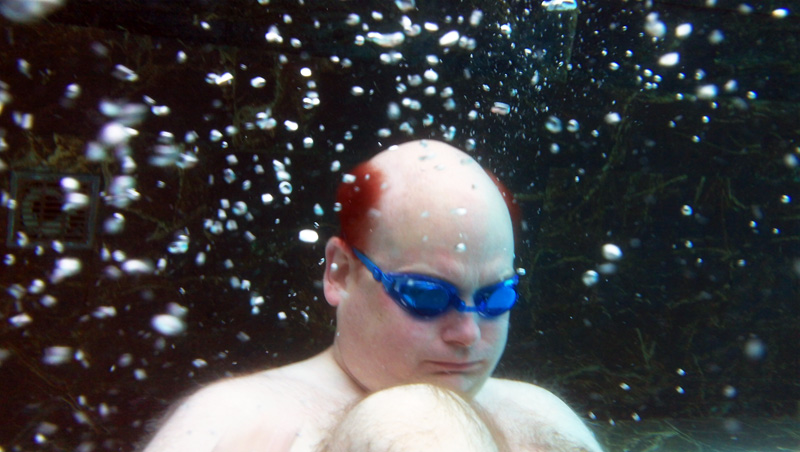
Patrick Goodspeed
The goal is, as always, to experience together, and to create small ripples of seductive difference in our social fabrics.
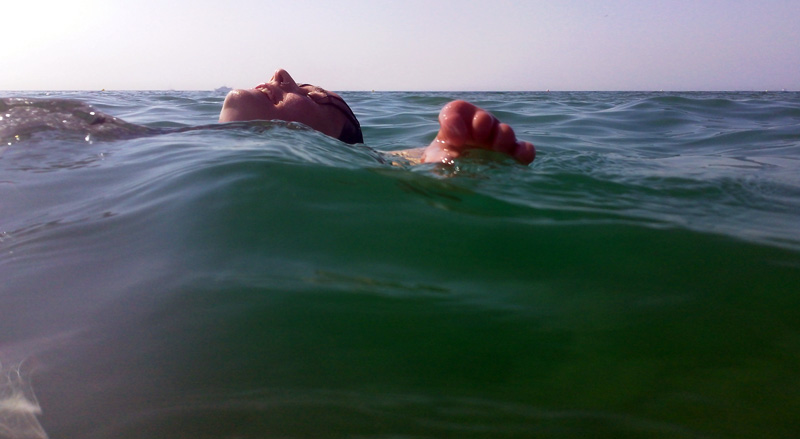
Colette Conroy
Community Writing
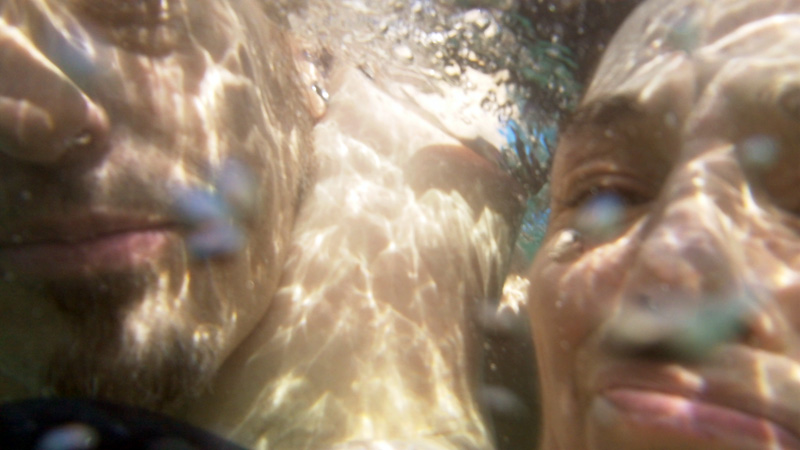
A Salamander from Barcelona’s Nova Icaria beach. In the image are two people, distorted by the water pressures, the angle of the camera, and the bubbles that accompany their descent. These are salty waters: it is hard to immerse oneself, we all float. Among our multiple bodies, many limbs are paralyzed, and do not go under with our willful control. We have to come up with work-arounds: holding on to each other, shifting us downward as we climb down each other’s torsos suspended vertically in the water column. And then the waves, crashing into us, shifting the scene every few seconds, upending orientation.
The image captures two people, just beneath the surface – the shimmer of the membrane between saltwater and air is visible just between them, a triangle. Maria and Xavi look serene, in the pulls and pushes of this medium, and they are close. An arm drapes across Maria, she is close to Xavi’s chest. My gaze is drawn to her half-open eye, looking through a blurred air bubble. She seems to speak, to communicate, so close, under the sea. Xavi’s chest is a nest of flashes of light, of sun’s scars. It looks welcoming, perfectly formed for Maria’s cheek. His earring captures the sun, and flashes out. Between the two of them, and the reflections of their flesh on the underside of the sea, is a seam of blue, the sky opening up in this embrace. On the edges of the image, the faces bleed into darkness, an intimacy of connection to the deeper water, away from the sun’s exposure.
Mergers of dark and light: salamander’s photographic history intertwines with alchemical heritages of pressure and transformation. Much is silence in our project, and in these Salamander in the Mediterranean Sea, this is even more apparent than in our US adventures. We have multiple languages in the water, different tongues, and the pressures and waves make us swallow salt, water and touch. As our spoken words peter out, smeared across Castilian, Catalan, German, English and some French, shifted into breathlessness by the wild oscillations of the sea, the fluidities of other communications take over. Partial knowledges reveal us to each other as we lean into the other’s curves, as breasts shift against one another, as the waters throw us together, crips in the sea. At the cusp of the wave, we go under, together, and cut off one lifeline in trust with each other, to border outward. In pressured environments, we become Maria, Xavi, Petra, unknown, together.
--- Petra Kuppers
Two people underwater, one marked as male by his beard, one ungendered by the water’s distortion. Bubbles glisten in the background and create blurry spots in front of their faces. Reflections from the sun tattoo his arm as it reaches behind, separating their faces. The bluish, blurry spots limit the viewer’s ability to access their faces. We must pull back and see the image as a whole rather than figure out who these people might be. We cannot read who they are through their eye contact or facial expressions. We can’t “know” them.
The water, the sun, the bubbles create the image as much as their faces do. The resulting complex of elements demonstrates how context always affects how we see. Barriers of various sorts block part of our vision. Our expectations shape what we see. Existing conditions highlight some elements. Our pet issues distract us from the full picture.
In pulling back to see as much as we can, we must still make decisions. To focus on the bubbles in the background, our pet issues? To explore the barriers that prevent us from fully seeing their faces? To focus on how the sunlight emphasizes his arm, to the detriment of their faces?
Viewing and analyzing is a dance, a poetic movement among the different facets of an image or idea. Deep focus on a detail provides one type of knowledge; focusing on structural barriers provides another. The macro-view provides a nice overview, but the details get lost. Personal responses can access an affective register. Sometimes you need to find out more, such as who are these people and why are they under water? What do the seemingly serene looks on their faces mean to them? Who are they? Do we need to know?
--- Beth Currans
Ser Salamandra, ese es la cuestión.
En esta vida hay que poder transformarse, mental y corporalmente.
Bajo el agua todo se transforma.
En el agua el cuerpo recibe impulsos de vida, otra mobilidad, otra manera de danzar la vida.
--- Xavier Duacastilla.
Barcelona a 1 de agosto de 2013
(Being Salamander, that is the question.
In this life you have to be able to transform, mental and bodily.
Underwater everything changes.
In water the body receives life impulses, another mobility, another way of life dancing.
transl. Xavier Duacastilla)
Neil Marcus
From Salamander cyber-free-write date, a meditation on the image above:
A man’s face in the center of the image, maybe smiling, maybe grimacing. His hand blocks the view of his left eye, turned at an angle, fingers pointing toward the viewer. The light dances in the water above his head, reflecting on his nose and the white shirt he’s wearing. He too dances, it seems, enjoying the water.
Moving in water; light dancing; body dancing.
Movement fluid.
Reflections of his face on the pool’s
surface.
He reflects light.
Nose illuminated,
mouth
in shadow.
Play of light
and shadow, water
and body.
Merman exploring, the water
holding him.
Pulsating.
Dancing
in water and light.
Dance reflected
on the surface.
Water movements
fluid. Electricity
provided by the body
and light.
No air bubbles.
The breath is within.
As long as there’s breath, remain
in the water.
Then surface
visit.
Humans are bound
to the land, the opposite
of mer-folk.
No gills, no fins. The water is a brief
retreat.
Suspended moment of dance, play,
reflection. Not static,
but bounded.
Light plays by different
rules, bent by water.
Life too.
Bent, twisted,
water dance.
No linear
movements, no straight
lines. Fluid.
The water is a refuge for the offbeat,
the bent,
the other-than-straight. Fluidy
forgives.
The body and mind can remain
fluid as they encounter concrete
streets, impassible
steps, closed
minds.
The dance can
emerge with us, dripping
from the pool
-- Beth Currans
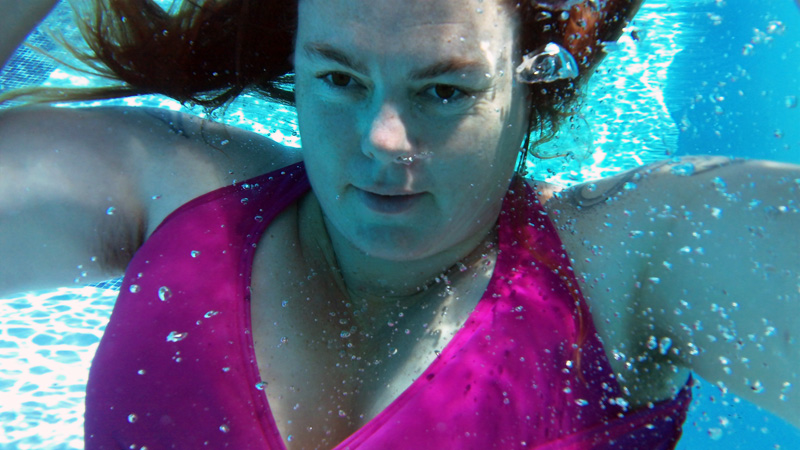
Beth Currans (during Performance Studies international meeting in Stanford)
Salamander Videos
Neil Marcus has created videos of us in the water:
He is collecting video footage from each swim date.
More Salamander Free-Writes
The last salamander I saw in San Diego was not at the body of water I was speaking of when walking in the water there and here with the sense of mom in both places now that she is gone. It was not in the ocean. It was not in the uncanny valley. It was in the mountains. It was black with red spots. Or maybe I’m making up that it was black with red spots because I want to be inside the myth of all things wet. Landed, I think of all things wet. In the ocean, you don’t think of wet/dry, hot/cold, alive/dead…you think of ocean. I think of not just the sentient being, “a salamander” but just the word too. Sal/mander. They show up in my poems. I’m not sure why. It doesn’t matter. There they are. I am now in a circle of salamanders. We write and write. They do not look like us. I am grateful that demarcations of wet/dry, land/water, beginning/end do not matter. They are both things at once as are we.
Later I dream: of a phosphorescent salamander singing.
Later still I dream: my friend who is dying sits cross-legged on the floor with a blanket wrapped around her but then the blanket is not a blanket it is an octopus.
I dream these in the same night. The family Salamandridae surround. They have something to do with writing in the near amphibious rain.
-- Denise Leto
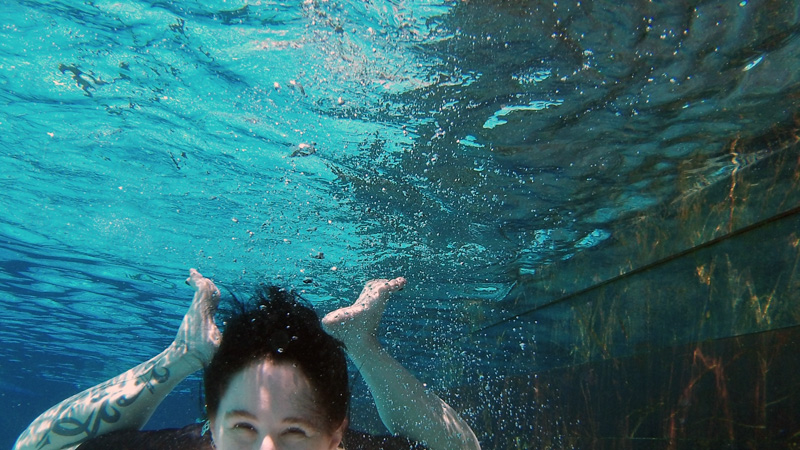
Bree Hadley
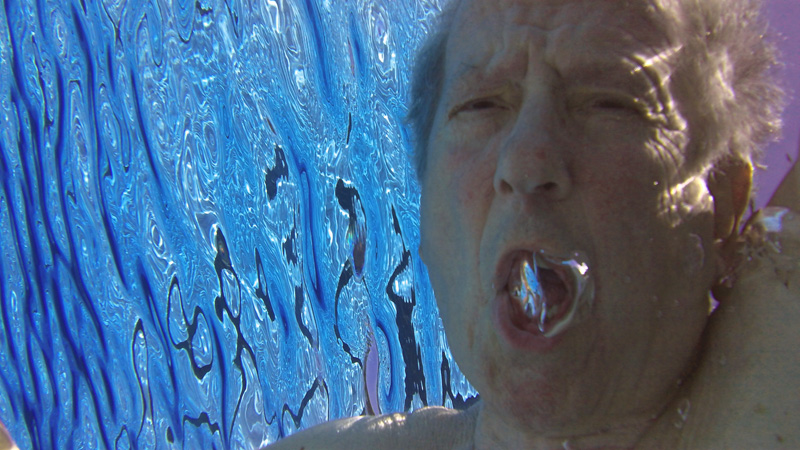
Adam (the late Paul Cotton)
From free write about this image:
Adrift in wildness: to me, this image speaks to the oracle. The Delphic priestess secluded and away in a cave, breathing toxic fumes, and given riddles for answers. The reversed air in Adam’s mouth, made visible in the water, speaks to me to the different toxicities that surround Salamander’s wider project. Water with chlorine keeps some of our playmates out. There’s some dust in the air: the university is taking down one of its old buildings nearby, and terra forming is experiential both in this slight taste of dust, and in the jackhammers that drown out the Glockenspiel at noon. This is civilized land, shaped, conquered, and the natives and the non-natives are at odds: will the Eucalyptus on the Oakland Hills survive the new fire remediation work that is supposed to use masses of Monsanto pesticides to make the land ‘safe’ for native species? This is the big environmental debate that shadows the locality of our photo shoots right now. The smell of eucalyptus is all around us when we wheel to our meeting site. And as you round a corner on the way to Hearst Pool, you will find a stencil on the wall: ‘build on blood.’ These buildings have toxic histories. Strife, invisible, shapes each corner of our life world. And here we are, floating in the pool, finding our wilderness in the abandon of a different gravity, in the public permission to touch and stroke another’s skin, to hold each other, to hold more than one, to share warmth in the welcome cool of a sun under a noonday sun, a sun ever more toxic itself with the thinning of ozone above us. The photograph is a memento of a moment of oracular clarity, of a prism of poetic insight assembled like Benjamin’s starburst: an assemblage of different discourses intertwining in the way that our arms reach out to each other. The moment lives, and then vanishes. Air, water, the struggle to breathe, the place for toxic substances of addiction, both in our life histories and in the consumer practices we are part of and that shape the material realities that lean into our membranes. What do we let in? In the run-up to making this photograph, to our Salamander meeting, chemical addiction issues are a theme in our group: one of the facets of disability The Olimpias members know about. What does freedom mean, conscious choice, in the pressure of an animal need? What are the creaturely drives of instinct and desire in our group, and how can we hold space for them?
Adam floats, an oracle, air made visible, like a scream, like a life line, and his white hair entwines with the sinuous lines of watery writing.
-- Petra Kuppers
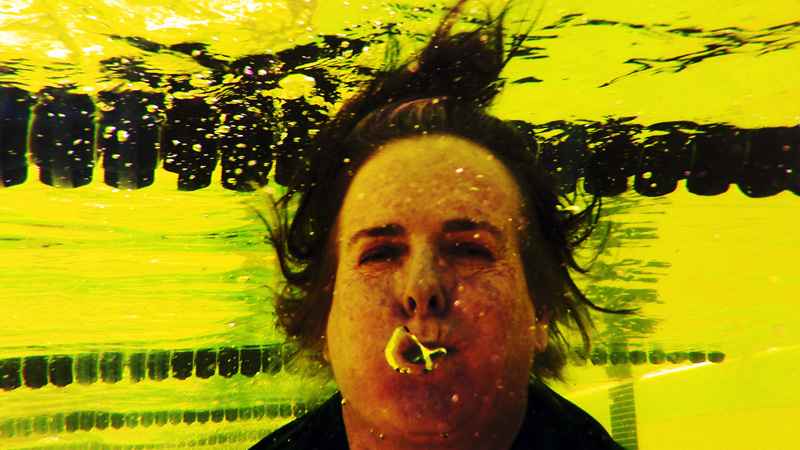
Janet Gibson
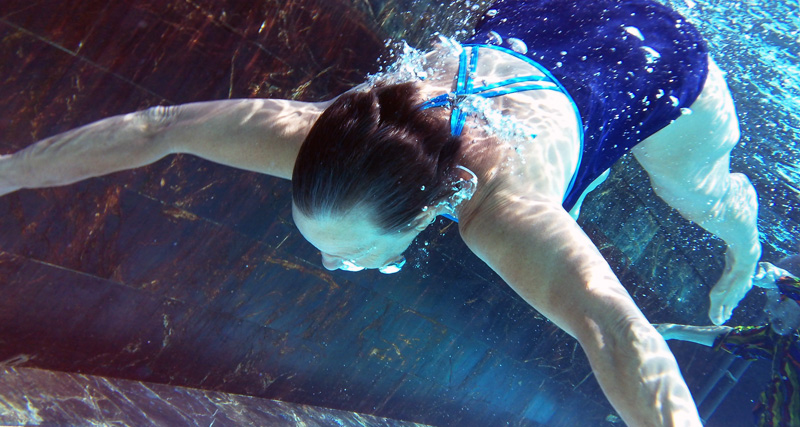
Kristina Yates
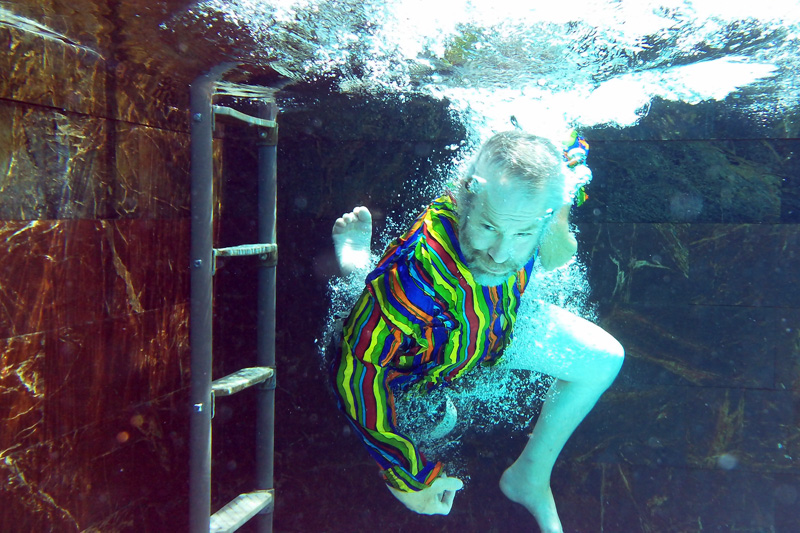
Neil Marcus
Free-write shared on the Salamander list-serv:
it is hard to get to the pool. I mean…it has been over the years.
but lately its been easier. its art. its performance. its …..Showtime..
water has always been my comfort. I fall into i.e. jump into it….totally. it’s the only place. I can…fall.. my body be itself. just who I am. me Spastic…falling.
turning, twisting, writhing.its o.k. water. in water face down. holding breath..like a alligator/log. first thrashing as Tarzan gets me in his grip. I thrash in resistance grappling with him. then I am subdued…appearing lifeless. though not lifeless at all.
this leads me to theater. the stage. the fourth wall.
I feel also very at home in this world.
the fourth wall, to me is like …as I am…in water
another element is the audience. in the pool it is the camera. I kno this lens. I can work with it. it is capturing new images. I know they are there but because I cant see myself..my reflection made visible;is this fourth wall observer
I am egged on. I know what I have to 'say' is important.
'ACTOR' is such a charged word. i guess it means being seen
and knowing how to relate to oneself onstage in front of an
audience. STAGES are magic places
-- Neil Marcus
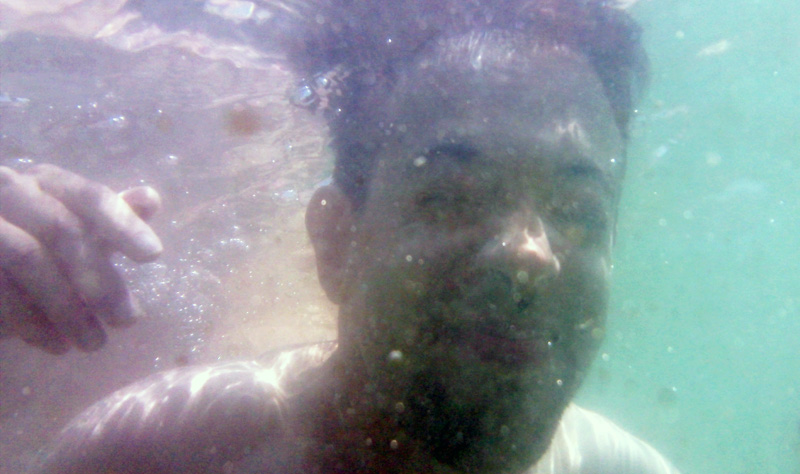
Erik Ferguson
Swimming off Barceloneta - freewrite
The water is turbid: this is near the surf, the most unstable part of the ocean for bipedals. This is near the danger zone for me, where I can’t walk, where I can’t help. I am watching Erik struggling into the water, watch Brook standing by, observing him but not helping needlessly: she knows what to do and when not to interfere, when help is unwarranted. But a Spanish man coming by does not know that: he shouts at her, chews her out for ‘leaving Erik alone.’ Since none of us have good enough Spanish, we can only fume inside.
Erik continues on this crawl into the water, and eventually, he is through the roughest surf, and I can extend my hand to him. We cradle each other in a mutual embrace. Brook joins us, and she holds Erik, too. We are connected, and drifting. For a while, there are short gasps and stiffness. This is not our natural medium. Then, it’s becoming more peaceful. We turn away from the busy beach and toward the calm, quiet horizon.
Waves roll in, and lift us. We let them, eventually, as we do not fight any more. Lift, roil. Breathe. Skin to skin. We all have bared our chests: here, on the Barcelona city beach, lots of women of all ages are bare-topped. We see few explicitly gender-queer people, though: between us, we have scars, tattoos, blue hair and other adornments that seem a bit unusual on this beach, but it’s fine. Apart from the one guy, no one else hassles us.
The disability scene is fantastic: there is a station for disabled beach goers, and five buff beach guards hang out there and help disabled people. It seems quite the hook-up and hang-out place: in the time we are there, I see a bunch of gloriously naked people with unusual bodies, glistening with oil, boobs to the sky, with entourage, engaged in playful banter with a mixed-gender crowd. One of the crips, a guy with strong arms and no legs, can speak some English, and is helpful to us. This is pretty near heaven.
The guards lend me crutches with big plastic cups at the bottom, so I can easily get down the ramp that leads into the waves, and they keep my powerchair safe while I bob around in the sea. Later, they get Yulia and Erik off the sand with the big yellow crip beach mobile, cheerfully lifting disabled bodies, offering to hose us down, and to tie Yulia’s shoes.
Cheers and laughter, warm skin pressing into mine in the gentle waters, an embrace of more than two, tender breasts leaning into another’s soft tissue. I can see Erik’s lips turn blue, eventually, and the color reminds us that no, this caress is not a homeground, there is danger here. We have to leave. We shout to someone on the beach, and he comes and helps us get out, get past the surf again.
The sea sucks at me one last time, clasps my feet and tries to hold me back, and I could let myself fall backward, backward, downward, so easily, to give myself to this gravity, to rest in this pressure so delicious to tissues, to relieve the pain. But it’s time to go. Crip time, in rhythm.
--- Petra Kuppers
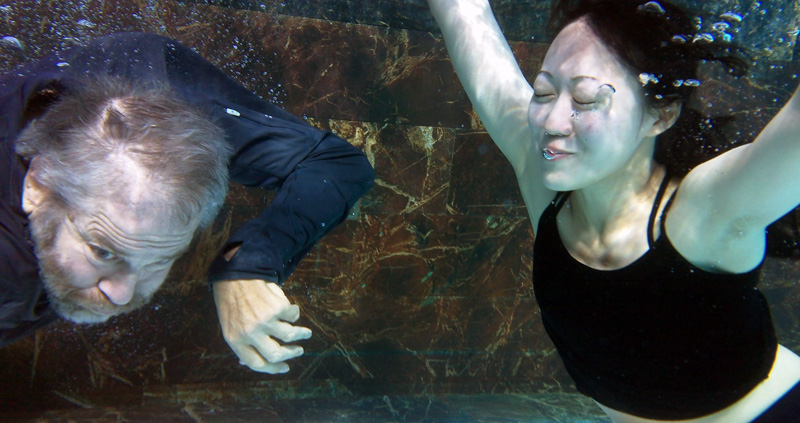
ChiaYi Seetoo and Neil Marcus
Not so much afraid of water now. Perhaps it’s the warm weather, I actually wanted to swim. Not athletic swimming. Just to have fun. Both your bodies are warm. Soft, buoyant, tender, floating in the water. Tried to dive without goggles on. Then tried to open my eyes. Then tried to stay under water longer. Came up with ways to wave my limbs around, snake my torsos. Neil can stay under water for so long. Amazing. I kept floating back up. What great fun to just float in a warm but not too hot late afternoon in Berkeley. For a moment we all became like kids. Just a moment of playfulness, being together, beyond words.
Dance under water. Work with the buoyancy. Not about defying gravity, nor embracing gravity. Not about erecting or jumping higher, nor “sinking” or “releasing” into the floor, as we might say, when working to inverse a certain upheld aesthetic expectation--of dancing on the ground, dancing on the plane. But water! We are really dancing with it. We are all cuddled and surrounded by the water. We are working in another way. The water lifts our limbs and we succumb to this tender choreography. A tender adventure.
--- Chia-Yi Seetoo
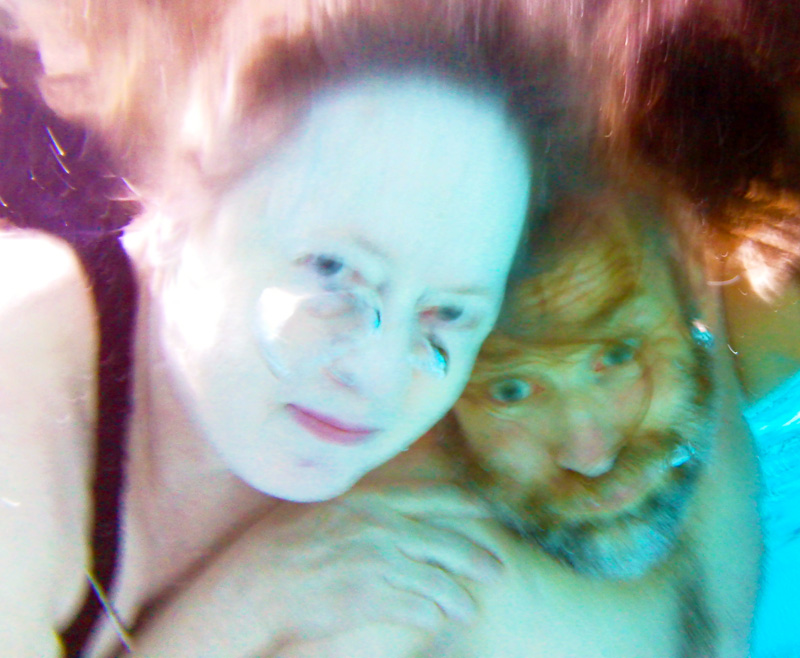
It had been glorious. The next day I woke and my shoulders were hard and strong. They were happy I had let them swim again. I had to think. Do I want to swim once or twice a week there and take a powerful, immunosuppressive, blood-vessel-damaging drug afterward? No. Do I want to search for the perfect goggles that, hypothetically, vacuum-suck out every detergent- and bleach-infused drop of pool water? Not if they crush my skull like a vise, as most goggles I've found do. Was this experiment valuable? Yes. Who is "more disabled"? Someone who speaks slowly? Someone who needs a wheelchair to locomote most of the time? Someone who needs assistance feeding himself all the time? Or someone who needs to eschew public swimming pools, long plane flights, "smoke-free" clubs and bars and dance halls and concerts where tobacco smoke washes in from the addicts jonesing just outside the door, sleeping overnight with a boyfriend who lives with beloved cats, eating in most restaurants, eating most foods available in American stores. Someone who must bring her own food and her own bedding in order to travel. Someone who needs to live in a house with a special type of heating system, a certain kind of stove, a certain kind of many other things. Someone who cannot drive, visit, make love with many people because of things they do that they aren't even aware of. That it is taboo to talk about. That involves a notion of safety that is harder to discuss than it is to negotiate the official concept of "safe" sex. Who is "more disabled" is not. Is not a hierarchy. "More" is not. Hierarchy dissolves. Water dissolved: difference, sexuality and sensuality, adult and child, talk and laughter and breath.
--- Susan Nordmark
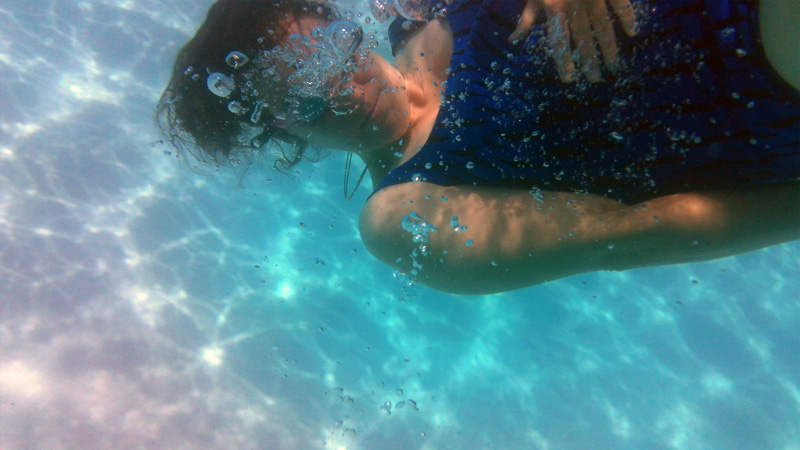
Margit Galanter
Today in my inbox was an art prompt from Petra Kuppers saying "what is your wilderness?"
Today my wilderness is the dream of walking through a leaf-mussed and dimly-lit path and stumbling into street lights headfirst; in conclusion: lampposts hurt your head, but bruises mark you being that much closer to a rest stop. Unmarked paths are still paths, all of them. Best not to litter.
It is lying down in a darkened room with an exhibit next door, riotous with color and people who have come alive from the dogged, spitting gifts of mixed media and textiles, having to speak out of the left side of your mouth and realizing you sound like Scrooge McDuck; in conclusion: it is all funny in some way, all of it.
It is feeling, in moments of breathlessness and needling in the flesh, that all this gorgeousness of life still can’t take away what your own body gifts to you that you can’t sit in comfort with, and then feeling the delicious warmth of a hella good lamb burger your patient, radiant hosts have brought for you in bed; in conclusion: it is hella good lamb, living is, all the stuff in the bun, even pickles.
Today, my wilderness is speaking to people I love in very different ways about the other people we love in very different ways; in conclusion: it is all love. It is. Sit tight with it.
--- Khairani Barokka
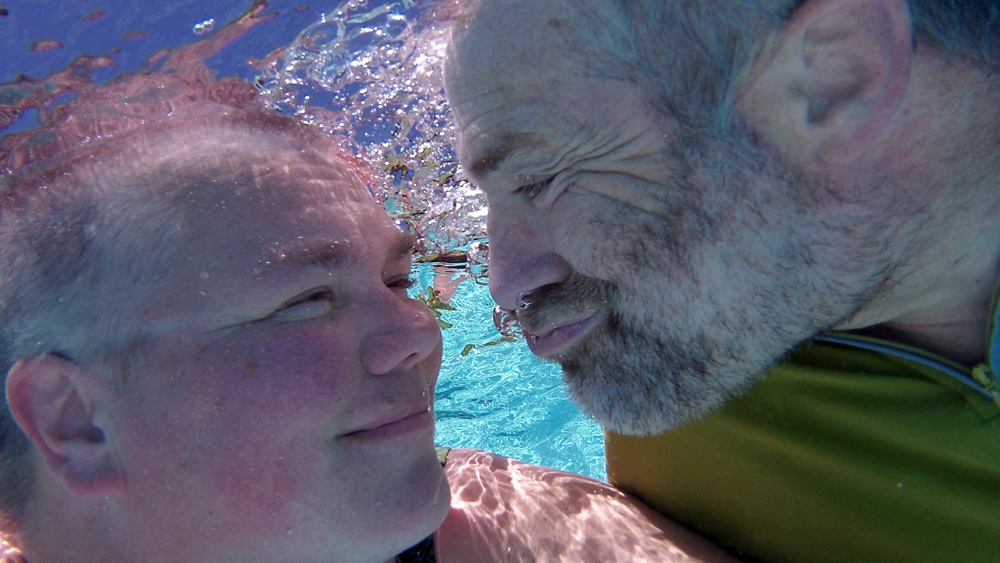
Neil Marcus and Petra Kuppers in San Diego
